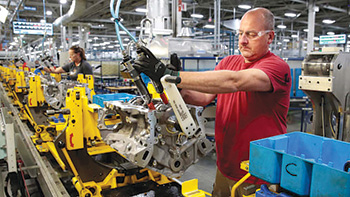By TIM ROWDEN
Editor

President Trump’s State of the Union speech spent a lot of time focusing on jobs and the economy, putting a predictably positive spin on his administration’s policies. The actual state of affairs for working people is a little more complicated.
The Economic Policy Institute (EPI) has assembled research from the last year that examines the impact of the administration’s policies on wages, manufacturing and trade, taxes, Labor standards, housing, and immigration.
WAGES AND EMPLOYMENT
- 2019 had solid job growth, but wage growth slowed. Average monthly job creation has held remarkably steady for the past nine years, but softened in the last year, from 223,000 in 2018 to 176,000 in 2019.
Wage growth slowed for much of the year, providing further evidence that we are not yet at genuine full employment. After hitting a recent high point of 3.4 percent year-over-year wage growth, the growth rate has measurably decelerated and wage growth closed out the year at only 2.9 percent in December. - Wage growth for low-wage workers has been strongest in states with minimum wage increases.
Wage growth at the 10th percentile in states with at least one minimum wage increase from 2013 to 2018 was more than 50 percent faster than in states without any minimum wage increases (13.0 percent vs. 8.4 percent). Given women’s greater likelihood of being in low-wage jobs, the result was even stronger for women (13.0 percent vs. 6.0 percent). However, men also experienced much faster 10th-percentile wage growth in states with minimum wage increases than in those without (12.0 percent vs. 8.6 percent).
MANUFACTURING AND TRADE
-

SOME 700,000 JOBS WERE LOST TO CHINA in the first two years of Trump’s presidency — many of them in manufacturing. Jobs lost to China. Despite the administration’s heated rhetoric and imposition of tariffs, recent EPI research found that 700,000 jobs were lost to China in the first two years of Trump’s presidency — many of them in manufacturing.
- China trade deal will not restore 3.7 million U.S. jobs lost since China entered the WTO in 2001.
Trump’s much touted “phase one” China trade deal is unlikely to significantly reduce massive U.S. job losses due to growing U.S. trade deficits — the difference between imports and exports — which are dominated by trade deficits in manufactured goods. - U.S.-Mexico-Canada Agreement (USMCA) represents a significant improvement on the draft agreement first released in 2017. Negotiators for Labor and House Democrats strengthened the provisions on labor rights, environmental standards, and the enforcement of these rules, and also removed costly and egregious new protections for corporations, including giveaways by the Trump administration to pharmaceutical companies.
But the changes embodied in the USMCA still constitute Band-Aids on a fundamentally flawed agreement and process.
Powerful multinational corporations have used and controlled the negotiation of trade and investment deals to facilitate offshoring and the deregulation of the U.S. and global economy, as noted by the Machinists Union, which opposed the USMCA.
The original North American Free Trade Agreement (NAFTA) resulted in the loss of at least 680,000 U.S. jobs due to growing trade deficits with Mexico alone. It also caused downward pressure on the wages of nearly 100 million U.S. workers and the devastation of manufacturing communities across the United States, especially in the industrial Midwest and battleground states—with far-reaching social and electoral consequences. - What’s good for Wall Street is often bad for American workers and manufacturing. An overvalued dollar is hurting American workers and main street manufacturers.
In order to rebalance U.S. trade, the dollar needs to fall 25–30 percent, especially against the currencies of countries with large, persistent trade surpluses such as China, Japan, and the European Union. This would help to address the trade deficits that have eliminated nearly five million good-paying American manufacturing jobs over the past two decades and some 90,000 factories. In fact, trade with low-wage countries has pulled down the incomes of 100 million non-college educated workers by roughly $2,000 per year.
TAXES

• The Tax Cuts and Jobs Act (TCJA) has been a policy failure. Notably, business investment contracted for the third straight quarter-the first time this has happened since the Great Recession in 2009. Given that boosting business investment was the primary stated goal of the Tax Cuts and Jobs Act (TCJA) passed in 2017, this seems like an unambiguous policy failure.
• On its second anniversary, the TCJA has cut taxes for corporations, but nothing has trickled down.
The centerpiece of the TCJA was a large cut in the corporate tax rate. Supporters argued that higher corporate profits would juice investment, which would eventually trickle down to faster productivity growth that would mechanically boost workers’ wages.
Two years later, there is no evidence of any investment boom. In fact, year-over-year investment growth sunk from 5.4 percent at the time of the TCJA’s passage to just 1.3 percent in the most recent quarter.
LABOR STANDARDS
- The Trump administration has systematically weakened workers’ rights. The Trump NLRB has not only issued significant decisions that hurt working people, but has also embarked in an unprecedented number of rulemakings aimed at overturning existing precedent that protects workers, faithfully acted on 10 out of 10 items proposed by the Chamber of Commerce as a corporate action wish list in 2017, and gone beyond the Chamber’s wish list to advance additional measures that give employers more power, while stripping away workers’ rights.
- More than eight million workers will be left behind by the Trump overtime rule, which will set the salary threshold under which salaried workers are automatically entitled to overtime pay to $35,568 a year.
- The New Trump administration joint-employer rule has $1 billion price tag for workers.
- Workers will lose more than $700 million annually under the proposed Trump DOL rule, which substantially narrowed the set of circumstances whereby a firm can be found to be a joint employer. (Firms that are joint employers are each responsible for complying with workplace protection rules.)
The new rule creates an incentive for large corporations to outsource work to staffing companies or subcontractors and escape responsibility under the FLSA. EPI estimates the rule will cost workers more than $954.4 million due to wage suppression from an increase in subcontracting or domestic outsourcing and more than $138.6 million from wage losses due to an increase in wage theft by employers. - Graduate student workers’ rights to unionize are threatened by a proposed rule by the Trump NLRB that would deprive graduate teaching assistants and other student employees at private universities of the rights to organize and collectively bargain.
HOUSING
- The Trump administration’s new housing rules will worsen segregation, making virtually impossible to challenge many policies that reinforce residential racial segregation and, as a consequence, make it harder to close the racial gap in academic achievement. A gap that persists in large part because our most socially and economically disadvantaged children are enrolled in poorly resourced schools, located in poorly resourced neighborhoods.
IMMIGRATION
- Trump and son-in-law Jared Kushner’s ‘merit-based’ immigration plan fails to propose the smart reforms needed to modernize and improve U.S. labor migration.
- Trump’s national emergency declaration over the border wall is dangerous and not justified by the facts.
Trump was so desperate to fund his signature campaign promise that he went gone so far as to shut down the government over it for over a month in 2018. The shutdown caused federal employees to suffer and billions of dollars-worth of economic losses. In response to failing to get the money from Congress, Trump declared a national emergency to achieve the same ends by different means. - Congress and Trump discovered one area of bipartisanship on immigration —increasing H-2B visas for captive and underpaid migrant workers.



This President wasn’t good when times were good this guy made history you will never see a president like this in your life time